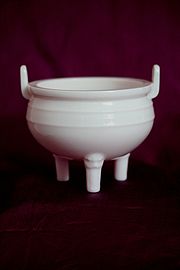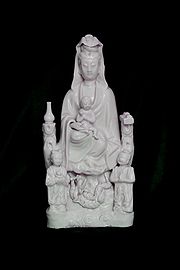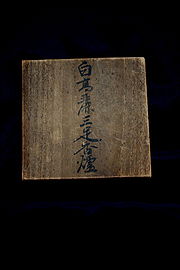
Blanc de Chine
Encyclopedia

Chinese porcelain
Chinese ceramic ware shows a continuous development since the pre-dynastic periods, and is one of the most significant forms of Chinese art. China is richly endowed with the raw materials needed for making ceramics. The first types of ceramics were made during the Palaeolithic era...
, made at Dehua
Dehua
Dehua is located in central Fujian, one of the provinces on the southeast coast of China.-History:Dehua is rich in kaolin and famous for ceramic products, especially crafts and dinnerware, including candle holders, Piggy banks, photo frames, jewel boxes, flower baskets, jars, vases, plaques, wall...
in the Fujian
Fujian
' , formerly romanised as Fukien or Huguing or Foukien, is a province on the southeast coast of mainland China. Fujian is bordered by Zhejiang to the north, Jiangxi to the west, and Guangdong to the south. Taiwan lies to the east, across the Taiwan Strait...
province, otherwise known as Dehua porcelain or similar terms. It has been produced from the Ming Dynasty
Ming Dynasty
The Ming Dynasty, also Empire of the Great Ming, was the ruling dynasty of China from 1368 to 1644, following the collapse of the Mongol-led Yuan Dynasty. The Ming, "one of the greatest eras of orderly government and social stability in human history", was the last dynasty in China ruled by ethnic...
(1368–1644) to the present day. Large quantities arrived in Europe
Europe
Europe is, by convention, one of the world's seven continents. Comprising the westernmost peninsula of Eurasia, Europe is generally 'divided' from Asia to its east by the watershed divides of the Ural and Caucasus Mountains, the Ural River, the Caspian and Black Seas, and the waterways connecting...
as Chinese Export Porcelain
Chinese export porcelain
Chinese export porcelain concerns a wide range of porcelain that was made and decorated in China exclusively for export to Europe and later to North America between the 16th and the 20th century.-Early China porcelain trade:...
in the early 18th century and it was copied at Meissen
Meissen
Meissen is a town of approximately 30,000 about northwest of Dresden on both banks of the Elbe river in the Free State of Saxony, in eastern Germany. Meissen is the home of Meissen porcelain, the Albrechtsburg castle, the Gothic Meissen Cathedral and the Meissen Frauenkirche...
and elsewhere. It was also exported to Japan
Japan
Japan is an island nation in East Asia. Located in the Pacific Ocean, it lies to the east of the Sea of Japan, China, North Korea, South Korea and Russia, stretching from the Sea of Okhotsk in the north to the East China Sea and Taiwan in the south...
in large quantities.
Dehua porcelain
The area along the Fujian coast was traditionally one of the main ceramic exporting centers. Over one-hundred and eighty kiln sites have been identified extending in historical range from the Song period to present. The two principal kiln sites were those of Qudougong 屈斗宫 and Wanpinglun 碗坪仑. The Wanpinglun site is the older of the two and manufactured pressed wares and others.The kilns of Dehua also produced other ceramic wares, including some with under glaze blue decoration.

Iron oxide
Iron oxides are chemical compounds composed of iron and oxygen. All together, there are sixteen known iron oxides and oxyhydroxides.Iron oxides and oxide-hydroxides are widespread in nature, play an important role in many geological and biological processes, and are widely utilized by humans, e.g.,...
in it, allowing it to be fired in an oxidising atmosphere to a warm white or pale ivory color. This color makes it instantly recognizable and quite different from the porcelain from the Imperial kilns of Jingdezhen
Jingdezhen
Jingdezhen , is a prefecture-level city, previously a town, in Jiangxi Province, China, with a total population of 1,554,000 . It is known as the "Porcelain Capital" because it has been producing quality pottery for 1700 years. The city has a well-documented history that stretches back over 2000...
, which contains more iron and has to be fired in reduction (i.e., an atmosphere with carbon dioxide
Carbon dioxide
Carbon dioxide is a naturally occurring chemical compound composed of two oxygen atoms covalently bonded to a single carbon atom...
) if it is not to appear an unpleasant straw color.
The unfired porcelain body is not very plastic but vessel forms have been made from it. Donnelly lists the following types of product: figures, boxes, vases and jars, cups and bowls, fishes, lamps, cup-stands, censers and flowerpots, animals, brush holders, wine and teapots, Buddhist and Taoist figures, secular figures and puppets. There was a large output of figures, especially religious figures, e.g., Guanyin, Maitreya
Maitreya
Maitreya , Metteyya , or Jampa , is foretold as a future Buddha of this world in Buddhist eschatology. In some Buddhist literature, such as the Amitabha Sutra and the Lotus Sutra, he or she is referred to as Ajita Bodhisattva.Maitreya is a bodhisattva who in the Buddhist tradition is to appear on...
, Lohan and Ta-mo figures. Guanyin, the Goddess of Mercy, was particularly revered in Fujian and there exist innumerable figures of her. Donnelly says, “There is no doubt that figures constitute the great glory of blanc de Chine.” Some have been produced with little modification from the late 16th or early 17th century. Crisply modeled figures with a smooth white glaze were popular as were joss-stick holders, brush pots, Dogs of Fo, libation cups and boxes.
The devotional objects produced at Dehua (incense burners, candlesticks, flower vases and statuettes of saints) “conformed to the official stipulations of the early Ming period, not only in their whiteness but also in imitating the shape of archaic ritual objects”. They were probably used in the domestic shrines that every Chinese home possessed. However, one Confucian polemicist, Wen Zhenheng
Wen Zhenheng
Wen Zhenheng was a Ming dynasty scholar, painter, landscape garden designer, and great grandson of Wen Zhengming, a famous Ming dynasty painter....
(1585–1645), specifically forbade the use of Dehua wares for religious purposes, presumably for their lack of antiquity: “Among the censers the use of which should be specifically forbidden are those recently made in the kilns of Fujian (Dehua).”
The numerous Dehua porcelain factories today make figures and tableware in modern styles. During the Cultural Revolution
Cultural Revolution
The Great Proletarian Cultural Revolution, commonly known as the Cultural Revolution , was a socio-political movement that took place in the People's Republic of China from 1966 through 1976...
“Dehua artisans applied their very best skills to produce immaculate statuettes of the Great Leader and the heroes of the revolution. Portraits of the stars of the new proletarian opera in their most famous roles were produced on a truly massive scale.” Mao Zedong
Mao Zedong
Mao Zedong, also transliterated as Mao Tse-tung , and commonly referred to as Chairman Mao , was a Chinese Communist revolutionary, guerrilla warfare strategist, Marxist political philosopher, and leader of the Chinese Revolution...
figures later fell out of favor but have been revived for foreign collectors.
Precise dating of blanc de Chine of the Ming and Qing (1644–1911) dynasties is often difficult because the conservatism of the Dehua potters led them to produce similar pieces for decades or even for centuries. There are blanc de Chine figures being made in Dehua today (e.g. the popular Guanyin and Maitreya figures) little different from those made in the Ming dynasty.
Notable artists in blanc de Chine, such as the late Ming period He Chaozong
He Chaozong
He Chaozong 何朝宗 was a celebrated early 17th century Chinese potter. He Chaozong fashioned mainly Buddhist white porcelain statuary in the tradition of the Dehua kilns in Fujian Province, known in the west as Blanc-de-Chine. Little documentary evidence remains for He Chaozong apart from extant...
, signed their creations with their seals. Wares include crisply modeled figures, cups, bowls and joss stick-holders.
In Japan


Butsudan
A butsudan is a shrine commonly found in temples and homes in Japanese Buddhist cultures. A butsudan is a wooden cabinet with doors that enclose and protect a gohonzon or religious icon, typically a statue or painting of a Buddha or Bodhisattva, or a "script" mandala scroll...
) and other funerary and religious uses. In Japan
Japan
Japan is an island nation in East Asia. Located in the Pacific Ocean, it lies to the east of the Sea of Japan, China, North Korea, South Korea and Russia, stretching from the Sea of Okhotsk in the north to the East China Sea and Taiwan in the south...
the white variety was termed hakugorai or "Korea
Korea
Korea ) is an East Asian geographic region that is currently divided into two separate sovereign states — North Korea and South Korea. Located on the Korean Peninsula, Korea is bordered by the People's Republic of China to the northwest, Russia to the northeast, and is separated from Japan to the...
n white", a term often found in tea ceremony
Tea ceremony
A tea ceremony is a ritualised form of making tea. The term generally refers to either chayi Chinese tea ceremony, chado Japanese tea ceremony, tarye Korean tea ceremony. The Japanese tea ceremony is more well known, and was influenced by the Chinese tea ceremony during ancient and medieval times....
circles. The British Museum
British Museum
The British Museum is a museum of human history and culture in London. Its collections, which number more than seven million objects, are amongst the largest and most comprehensive in the world and originate from all continents, illustrating and documenting the story of human culture from its...
in London has a large number of blanc de Chine pieces, having received as a gift in 1980 the entire collection of P.J.Donnelly.
Dehua white porcelain in Japan was traditionally known among Japanese as hakugorai or “Korean White Ware.” Although Korai
Korai
The Korai are a Baloch tribe settled in the Balochistan province of Iran, Balochistan Province of Pakistan; Sindh; Punjab provinces of Pakistan; and the Indian states of Uttar Pradesh, Rajasthan, Gujrat, Maharastra, Haryana, and Indian Punjab....
was a term for an ancient Korean kingdom, the term also functioned as a ubiquitous term for various products from the Korean peninsula.
This is not to suggest that historically Japanese were entirely oblivious to the existence of the Fujian province kilns and their porcelain, now known as Dehua or Blanc de Chine ware. The Dehua kilns are located in Fujian province opposite the island of Taiwan. Coastal Fujian province was traditionally a trade center for the Chinese economy with its many ports and urban centers. Fujian white ware was meant for all of maritime Asia.
However a large quantity of these ceramics was intended for a Japanese market before drastic trade restrictions by the mid 17th century. Items were largely Buddhist images and ritual utensils utilized for family altar use. Associations with funerals and the dead have perhaps led to a certain disinterest in this ware among present day Japanese, despite an intense interest in other aspects of Chinese ceramic culture and history.
Perhaps also likely is Japanese taste in the very plain white incense tripods and associated objects for Japanese religious and ritual observance. Of interest also are the Buddhist Goddesses of Mercy with child figures that close resembled Christian figurines. Such figurines were known as Maria Kannon or “Blessed Virgin Goddesses of Mercy” and were part of the “hidden Christian” culture of Tokugawa Japan which had strictly banned the religion.
White porcelain Buddhist statuary was extensively produced in Japan at the Hirado kilns and elsewhere. The two wares can be easily distinguished. Japanese figures are usually closed on the base and a small hole for ventilation can be seen. Hirado Ware also displays a slightly orange tinge on unglazed areas.

